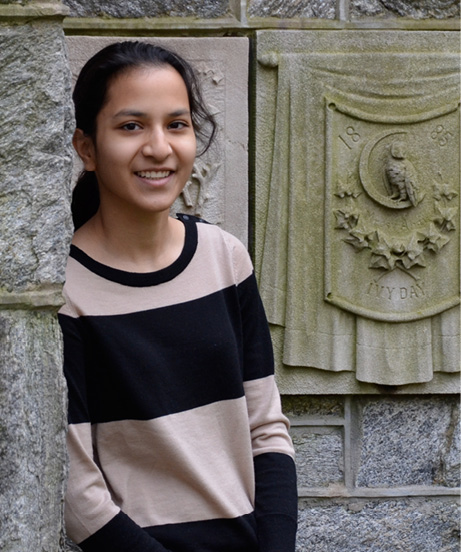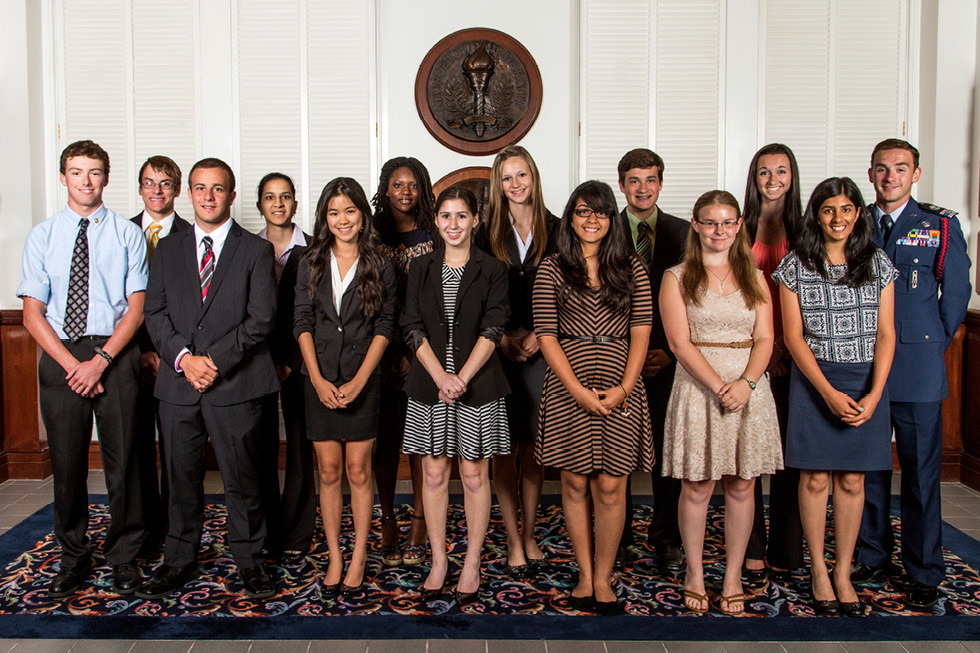Youth Preparedness Council
Kate Lahey
"Kate Lahey speaks to some of the members of FEMA's Youth Preparedness Council about the ways they are helping to make the USA more resilient to disasters."
Article

Image: Kate Lahey
Nimansha Jain.
The USA’s Federal Emergency Management Agency (FEMA) has some astute new advisors. They boast backgrounds in search and rescue, volunteerism, disaster recovery, emergency medical aid and operations centre communications among other things, and they’re providing expert guidance on how to better prepare the nation for disasters. All of them are aged between 13 and 18.
They meet in Washington DC annually for a summit, communicate via conference calls every six weeks, and use other technology for the rest of the year. The 15 members of FEMA’s Youth Preparedness Council take part in four standing committees, give presentations at conferences, and help spread the preparedness message. They also work on their own disaster-readiness projects in their regions—with FEMA’s backing.1
The council, formed in 2012, is now in its second year. The members were nominated by people who could attest to their work in preparing for disaster, and their resumes are wide and accomplished. Nimansha Jain, 18, is in her freshman year at the University of Pennsylvania. She provides input to the youth pages on FEMA’s Ready Kids website as a subject matter expert, and she is developing a website about preparedness, which will include basic tips, blog posts and information about the council’s activities.2
Over the past few months, as a member of the council, she has been working to pioneer a Community Emergency Response Team for her college campus. Known as a CERT, these teams are part of an existing FEMA program to train civilians to meet their immediate life-saving and life-sustaining needs in an emergency. The program is based on the assumption that when a major disaster happens, professional first responders will not be able to meet demand.3
Ms Jain, who is trained in CPR and has worked to promote public health and preparedness messages to teenagers in her home state of Nebraska, said campus CERTs existed in other parts of the country, but not in Philadelphia, where her college is based.
‘It is going to be one of the first piloted programs at a university and we’re hoping in the next few years to actually show the impact of this,’ she said.
She hopes to see it extended to other colleges and universities in the area.
Knowing that FEMA was behind her was a big source of motivation for her projects, she said.
‘The opportunity to be on this national preparedness council is an honour and I think having that support from FEMA makes us realise, definitely, what we’re doing is being supported.
‘It gives us the push to continue this further and continue working on our projects.’ Ms Jain said.
FEMA’s Youth Preparedness Director, Regina Moran, said the council was formed to allow young people to speak and act for themselves on emergency preparedness issues.
‘My job is largely to make sure the youth community is represented in preparedness activities and that we push forward that movement and, truthfully, it felt uncomfortable doing so without the actual youth perspective, which is sort of what started the idea around the council.
‘They represent a youth perspective on emergency preparedness. They’re a great resource to us and provide their opinions, share their experiences and they recommend solutions to issues that we have,’ Ms Moran said.
Those issues include ways to engage young people, ways to better incorporate a youth perspective into programming and, critically, ways to get messages home to parents and the rest of the community.
‘All of our 15 members have projects that drill down into their communities and help to advocate—to promulgate the message about youth preparedness and get more kids engaged. They also reach students in a way that a large federal agency has a harder time doing. They really help us to push our message and that’s largely the purpose of the council,’ she said.

Image: FEMA
FEMA’s Youth preparedness council members including Nimansha Jain, Daniel Wernsman and Jason Reed (back row: second, fifth and final from left).
As well as their individual projects, the council members work on preparedness projects as a team. Two council members recently joined a FEMA panel to update a youth preparedness program that operates in some schools.
The program managers found the young people’s input very valuable as they were hearing from the kind of students who would be doing the program, or who would have just come out of a program like that, Ms Moran said.
‘That kind of advice and that kind of perspective is really invaluable to us. It’s something that’s very unique because of their age but also their experiences.’
Ms Moran said selecting the members of the council was the hardest part of managing it. ‘I usually spend those weeks in tears because it generally means that hundreds and hundreds of really awesome, great applicants aren’t selected,’ she said.
Last year the council had 12 members, this year it has 15 from across FEMA’s ten regions. ‘They represent very different communities and I think that’s really important,’ Ms Moran said.
The chairman of the council is 18-year-old Jason Reed. He is the cadet commander for his Civil Air Patrol squadron in Indiana and has served for several years with the squadron as a search-and-rescue ground team member.
He was a first responder after tornadoes struck his area in March 2012. He conducted health and wellness checks, created perimeters around damaged areas and distributed supplies to those affected by the storm. He received state-level recognition for his efforts.
In his first year on the council he organised a group of young people to provide feedback on a FEMA student program, which some of the young people had previously done.
‘I re-put them back through the program, even though they’re much older now, and asked them for their feedback on changes,’ he said.
Now his role is to oversee the council’s projects, including its four standing committees:
- Constitution and Bylaws - to establish rules for how the council works and conducts its business.
- Public Affairs – to help with publicity about the council.
- Cooperative Affairs – to deal with requests from organisations such as the American Red Cross.
- Preparedness Ambassadors Program – to develop a merit program for other young people to earn recognition as FEMA preparedness experts.
Mr Reed said the ambassadors program committee was trying to create a new, prestigious award for people under 25 who would complete a list of strenuous requirements with FEMA.
‘That’s kind of a new initiative that I helped design with some of the members and we’re really hoping it takes off. There’ll be separate levels like a basic senior and master level to the program, but it’s meant to be similar to the Boy Scouts’ Eagle Scout.
‘I’m hoping it will take that hold in the emergency management community to where, when people walk up and they say “I’m a preparedness ambassador from FEMA,” people understand their background, they understand where they’re coming from,’ he said.
Mr Reed said the combined experience of the council members and the fact that FEMA was behind them meant that the collective voice of the 15 young people was taken seriously.
‘When we say something, the agency’s right there to back it up. We don’t have to worry about it being 15 of us just saying something. We have the backing of the agency and the Department of Homeland Security. It’s really a great way for youth preparedness to come from youth,’ he said.
Daniel Wernsman, 16, has been involved in youth preparedness for four years, through a READY Club (Responding to Emergencies and Disasters with Youth) in his state of Wisconsin. He is now working to expand the READY program into his school and wants to extend it to other states in his region.
Daniel said his involvement on the council itself, and his attendance at the summit, was helping to raise awareness about disaster preparedness among his friends.
‘When I first came back I was really excited and I’d just met a whole bunch of new people and I just kept talking about it with my different friends and I was posting things on my Facebook. Lots of the ways that I get out what I’ve learned with my preparedness and my experience in Washington is through social media,’ he said.
FEMA provides personal support, advice on funding sources and other help to council members for projects like Daniel’s. Members are assigned to a community preparedness officer in each of their regional offices.
‘Those people are meant to be sounding boards and mentors for the member’s time on the council,’ Ms Moran said. They can also work with Ms Moran herself and draw on FEMA’s technical assistance program.
‘As they encounter issues with either volunteer engagement or interest or perhaps even funding, the technical assistance program provides support, advice, connects them with programs that have already encountered that issue and figured out a way to address it; any sort of technical assistance that we can help them with.’ The technical assistance program was available to others outside the council too, she said.
Shortly after the council formed in 2012, Superstorm Sandy hit the east coast of the USA and one council member became a FEMA applicant for disaster relief. But more than that, the young member organised a coalition of young volunteers to help with the relief effort, Ms Moran said.
Ms Moran expects much of what the council achieves will happen slowly. As Mr Reed told a recent think tank on the subject; reaching this generation of young people was critical to creating life-long changes in behaviour.
Ms Moran said, ‘It’s a slow moving process, but that’s an incredibly critical element to overall preparedness. I’ve long quoted that, “while parents might make the rules in a household, the kids set the priorities”. When they come home, it’s what they want to do and what they’re talking about and what they’ve learned at school.
‘So, while it’s a very nice thing that we’re getting their perspective, it’s also something that’s incredibly necessary as a strategy for getting messaging home to working parents and guardians,’ Ms Moran says.
Applicants to the council must be aged between 13–17 years and serve a two-year term. Among the criteria on which they’re chosen is their dedication to public service, their potential to be advocates for youth preparedness, and their individual efforts to make a difference.
1 At: /www.ready.gov/youth-preparedness.
2 At: www.ready.gov/kids.


